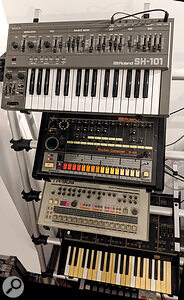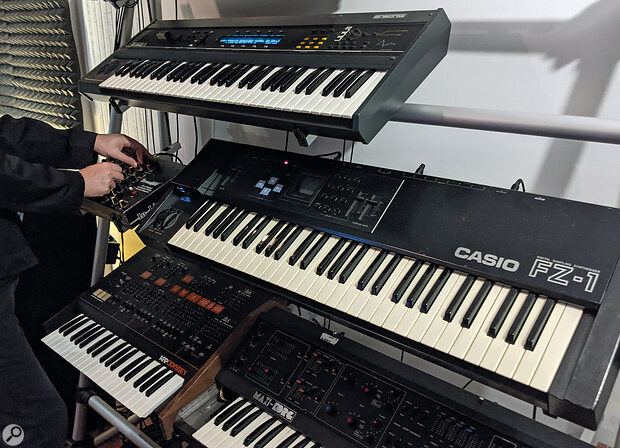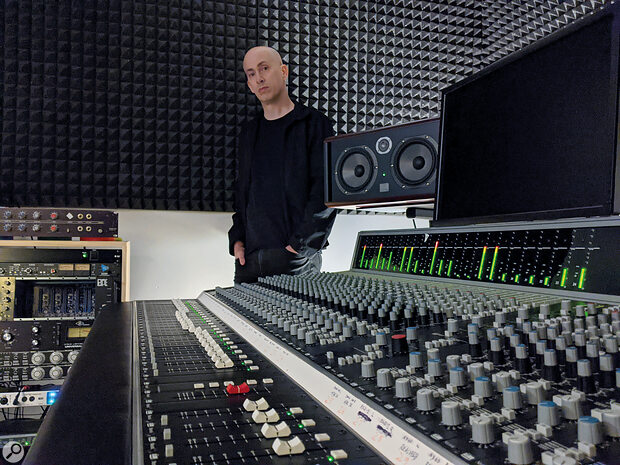Enigmatic New York producer Morgan Geist began making techno in his ’90s college dorm before a remix turned his life upside down.
Every producer has their own way of doing things, and for Morgan Geist, the devil is always in the detail. In the 2000s, he and childhood friend Darshan Jesrani released music as Metro Area and became torchbearers for a new wave of electronic music that married disco sensibilities with techno proficiency. His 2010 track ‘Look Right Through’, released under the name Storm Queen, went to number one in the UK thanks to a remix by house music legend MK as part of a re‑release on Ministry Of Sound in 2012. But the original has its own place in dance music history nonetheless, and Geist’s knack for focusing on the essentials and eschewing superfluous effects or music‑production fluff is immediately identifiable.
“With electronic music in particular it’s so easy to keep adding things,” he says on a Zoom call from his apartment in Queens. “I like trying to have all the ingredients be able to stand on their own so I’m really into being brutal about not using things to cover other things. Everyone has their studio tricks, but I don’t want to add a delay because something’s sounding boring.”
One Off
Examine Morgan’s discography and you’ll uncover different layers to his sound, spread throughout the past three decades — but spread thinly. His work with Darshan as Metro Area formed the bulk of his output in the ’00s, alongside an impressive collection of remixes. Two solo EPs were self‑released in 2015 and 2017, on his long‑running and quietly influential label, Environ. Storm Queen, his most commercially successful project, debuted with ‘Look Right Through’ in 2010 and was followed up with a couple of singles the following year — then nothing until ‘For A Fool’ landed on chart dance titan FFRR in 2021 (A&R Andy Daniel deserves some credit for this one after asking Morgan to finish one of his unreleased tracks from 2010). His latest project is Au Suisse, a collaboration with an old friend Kelley Polar. A self‑described weird mix of ’80s pop and new wave, so far it has amounted to a series of singles and an album on Berlin label City Slang.
“I have a lot of music that’s unreleased,” Geist says. “I’m really picky about what I put out and sometimes it’s not the best plan because why am I saving it? I don’t know. I just think there’s so much music out there, I don’t really need to add to it unless I think it’s really worthwhile.”
An admirable sentiment, but it helps if you have an iconic back catalogue hit to keep the gravy train rolling between releases. While Metro Area earned Morgan and Darshan prestige and an admirable touring schedule, ‘Look Right Through’ had a seismic effect on his life. “Storm Queen is sort of a memory at this point,” he says. “But when I first did the records it was really intense, surreal and amusing, but it also left me melancholic. Obviously MK did an amazing job but at the same time it’s such a chance to have something like that happen, it’s like catching lightning in a bottle. I felt extremely fortunate, but at the same time, I didn’t think I needed to make something else that seeds on a commercial level. If it happens that would be amazing. It was a wild experience but it wasn’t what I was aiming for.”
660 To 808
For those who, like Morgan Geist, learned to produce electronic music in the pre‑YouTube days, success hinged upon being lucky enough to know someone who could teach you or winging it in the dark with a badly written manual. Without the former, Morgan and Dashan persevered with little success for many years with the latter. It wasn’t until moving to study at Oberlin College, a sister school of the highly regarded Oberlin Institute where Kelley Polar studied, that Morgan’s perseverance caught the attention of Midwest techno legend Dan Curtin. By this time he had amassed a Roland Juno‑106, a broken ARP Axxe, a Kawai Q80, a MIDI‑only version of MOTU’s Performer sequencer, a Boss SE‑50 effects processor, a Boss DR‑660 drum machine and an Alesis ADAT 8‑track digital recorder, which at the time was a revolutionary machine for bedroom producers. “I saved and saved for one. It was so expensive, and now people won’t even use them as doorstops.”
The ADAT enabled him to make his first records. “I would lay down SMPTE sync on one of the tracks and just record the Juno over and over again. Since I only had seven tracks on the ADAT, I’d also be running everything live and mixing it all down via a Roland M240 line mixer with no EQs into a DAT machine.”
 The holy Roland trinity is still at the core of almost everything Morgan Geist does.The stumbling block was that his DR‑660 couldn’t compete with the classic Roland drum machines that were already cornerstones of house and techno music. Then, in 1993, Morgan was walking past a music store in a shopping mall in Western New Jersey. From 40 or 50 feet away, he spotted a black case with a white button sticking out from the back of the store. “It was like some weird superhero vision where I was like, ‘There’s an 808 back there!’” he says. “I had wanted one for my entire life. I bought it for $200 and I remember driving home and repeatedly looking at it in the back seat and thinking ‘I can’t believe I have this thing.’”
The holy Roland trinity is still at the core of almost everything Morgan Geist does.The stumbling block was that his DR‑660 couldn’t compete with the classic Roland drum machines that were already cornerstones of house and techno music. Then, in 1993, Morgan was walking past a music store in a shopping mall in Western New Jersey. From 40 or 50 feet away, he spotted a black case with a white button sticking out from the back of the store. “It was like some weird superhero vision where I was like, ‘There’s an 808 back there!’” he says. “I had wanted one for my entire life. I bought it for $200 and I remember driving home and repeatedly looking at it in the back seat and thinking ‘I can’t believe I have this thing.’”
Finding the TR‑808 and, shortly afterward, a TR‑909 gave him the final pieces of the puzzle. “I remember sync’ing my SH‑101 to my 909 and being like “Jesus, I can’t make something bad,” he remembers. “I realised that anyone can do this, and that I wanted to wrest out of the gear a sound that sounded like me. Or, if I’m honest, a sound that sounded like a bad copy of Dan Curtin or Carl Craig, because that’s totally who I was copying at the beginning.”
Morgan nevertheless credits the success of his late‑’90s records to his years spent trying to make dance music with “the wrong gear. It made me try harder. I’m not saying my mixes were good, but it was not luck. I have OCD in the studio!”
Although the high‑tempo scene that his early records found a home in might seem a world away from the disco‑infused electronica of his later work, his musical identity was already evident in his first album Clear. Crisp sounds and samples were presented without unnecessary effects, and the arrangements were tightly crafted. And the samples from artists like Bettye LaVette, D‑Train, Herbie Hancock or Munich Machine hinted at a childhood listening to disco and boogie. “If you looked at the influences of that first album it almost seems like a Metro Area record,” he says. “But it doesn’t sound that way because it was constructed like I was copying my heroes at the time. UK stuff like Black Dog, B12 or Kirk Digeorgio.”
In the late ’90s and early 2000s, DAW software revolutionised music production, and the new workflow became the impetus to begin Metro Area. “The first remix I ever did with a DAW was a band called Telex. The way you used to do remixes was someone would send you a DAT of a bunch of little sounds — people weren’t sending you multitrack tapes unless you were a big‑budget kind of person — so you cut them up, put them in your sampler and made your own new song. With that Telex remix, they sent me the whole vocal and I was just like ‘Wow, I can do anything now! This is insane. I don’t have to sample and sequence it. I can record handclaps like they were recorded in disco, where each handclap would be different throughout the record.’”
Morgan Geist: The way you used to do remixes was someone would send you a DAT of a bunch of little sounds — people weren’t sending you multitrack tapes unless you were a big‑budget kind of person — so you cut them up, put them in your sampler and made your own new song.
Old Ways
Today, the Roland classics on which Morgan Geist made his first records still take pride of place in his studio in Queens. “I still use my Juno‑106 on my records now,” he says. “I still use my 909. Every record I make, I record the 909 in and chop up the kicks or whatever. It’s actually perverse because there’s no need to be doing that. I could use them with my eyes closed.
“Then there’s the synthesizers I was obsessed with and that once I got them, haven’t made their way onto a lot of music. I was really obsessed with the Maxi‑Korg and when I got one I opened it up to modify it because you couldn’t control it externally but it’s so intimidating inside, so much wiring all held together literally with strings that were tied together in 1974. It sounds great but I haven’t used it that much. I just always go back to the old standards.”
 The Maxi‑Korg (lower right) was one of Morgan Geist’s dream synths, but has seen less use than expected.
The Maxi‑Korg (lower right) was one of Morgan Geist’s dream synths, but has seen less use than expected.
The style of the project also plays a part in his choice of instruments. “If it’s dance music or something where the sound is more important than the composition, you need to be really selective about your sound generators and put those and your processing first,” he says. “But if you’re doing a pop record, I actually prefer the convenience of having a million soft synths I can just knock something up with, knowing that later on then we’ll take our time, and not really care because we’re songwriting. The main thing is to just get the song finished and sketched out without thinking about sound yet. I feel like that’s more like the old rock & roll process where you’d make a demo — and having never been into rock music, it’s new to me.”
His other obsession involves pro audio outboard. “Three‑thousand‑dollar compressors? It’s almost like my midlife crisis. In a way I think it’s elevated my game, but in another way I think 'who cares?'!”
The centrepiece of the studio, meanwhile, is a custom Neotek Elan TT 32‑channel console, a recent replacement for a Trident Fleximix 10‑2 that he sold to LCD Soundsystem’s James Murphy. “He’s obsessed with those desks and his production sounds great, so I probably made a mistake,” he laughs. “It was only 10 channels and I used it for tracking and mixing but it was like having a stick of butter with every meal. It was too much! It was so old I’d work all afternoon trying to get a bass sound right and I’d lean on the mixer and the whole profile of the sound would change.
 For the time being, Morgan Geist is still committed to mixing on a console with no recall — and all the additional work that brings!“Now I have this quite boring but huge Neotek desk. Jesse Lanza lent me her minivan that’s on the cover of her album and I drove out to Chicago to pick this mixer up and the guy promptly closed his company and retired. So I’m just screwed when something goes wrong with it!
For the time being, Morgan Geist is still committed to mixing on a console with no recall — and all the additional work that brings!“Now I have this quite boring but huge Neotek desk. Jesse Lanza lent me her minivan that’s on the cover of her album and I drove out to Chicago to pick this mixer up and the guy promptly closed his company and retired. So I’m just screwed when something goes wrong with it!
“I’ll use two channels and keep things in the box as long as I can while I’m composing, and then when it’s time to mix, it’s time to mix. I start using separate outputs from my D‑As, and EQ’ing and doing levels and effects, and then really get into it fully for mix time. The main reason it’s remained somewhat hybridised rather than a pure analogue mix is because the analogue console approach is not very flexible if you’re working on multiple songs at once. If you need to switch songs before final mixes, you’re forever taking recall notes and resetting faders and knobs and nothing sounds exactly right when you try to get it back up on the board. So I try to keep things in the box for as long as possible until I really start shaping the mix. It’s a lot of work having 32 channels and loads of dials and knobs and settings that you have to set and reset every mix. Honestly, I don’t know if I’d do it again.
“I go back and forth sometimes, and especially when my gear breaks and I have to fix it, I think ’Screw this, I’m just going to use plug‑ins!’ But I always go back to the hardware. There’s something about it.”
He pauses before ruefully adding: “You can make amazing records with a laptop and plug‑ins if you’re thoughtful enough about it. Being virtuosic is the key.”
The Reluctant DJ
In an age of Instagram DJs commanding six‑figure sums for performing with a USB stick and a pyrotechnics crew, Morgan Geist is an exception. He rarely listens to current dance music, preferring instead to “cruise YouTube for weird old records” (a habit that resulted in his 2005 compilation of lost Italo records Unclassics). He dislikes the showmanship of modern‑day DJ’ing, preferring the anonymity of the old days when the DJ booth was a room in the corner and not a front‑facing stage.
In the wake of Storm Queen’s success, he was deluged with offers to perform at huge events, but he usually declined them. “I’d say no because I just wasn’t going to sleep for six months if I said yes! But I’ve certainly said no to things out of cowardice. From a business standpoint it was probably quite stupid, but I just wanted to keep going to the studio and making music. I don’t want to sound ungrateful but it’s just not me. I’d rather be in the studio and not be seen than out front on stage. For years I was telling friends I needed to stop touring. It was really stressing me out. I didn’t avail myself of what makes touring more bearable. I don’t really do drugs so I just slept terribly and it just wasn’t something that was super natural for me.”
The success of ‘Look Right Through’ came at the right time, enabling him to step off the touring treadmill. “I’m a dinosaur really,” he says. “I’m someone who wants to produce records like they did in the ’70s. I was never really comfortable DJ’ing and I did a lot of it. But once I was there and it was a good club and I could play what I want, then I enjoyed it. But everything leading up to it was often filled with terror. It’s not why I got into music. I got into this music to make records and then at a certain point it became impossible to make a living only making records and you had to DJ or play live.”

